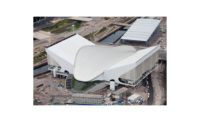| Photo ' Richard Bryant/www.arcaid.co.uk |
It has been eight years in the making, come in more than $15.8 million over budget, and been mired in litigation throughout its construction, but Rafael Viñoly’s $44.3 million arts center in Colchester, England, will finally open its doors on September 25.
The “Golden Banana,” as it has been dubbed by the townspeople, is a 41,000-square-foot copper-and-aluminum-clad facility built for the arts organization Firstsite. The Colchester council hopes the center will raise the profile of this provincial town with Roman roots, located just 60 miles outside of London.
Stemming from a 2003 invited competition organized by the Royal Institute of British Architects, the project brief called for a multistory building on a tight site adjacent to a bus station. In a controversial move, Viñoly submitted four schemes, two of which were not on the competition site. His Golden Banana proposal, housing all of Firstsite’s galleries and outreach functions in a single crescent-shaped volume on open parkland to the east of the original site, caught the judges’ imagination and won.
Instead of designing a multilevel building that would have required deep foundations—plus a full-scale archaeological dig to protect possible Roman remains—Viñoly developed a single-story approach. “There was simply no money in the budget for [archaeological] works, so the project would have stalled at the outset,” explained the architect. “Our one-story proposal was a ‘light touch’ . . . The building sits on curved concrete ring beams over site fill, with any Roman remains preserved beneath, untouched.”
After construction started, in 2006, problems beset the project. The fiendishly complex geometry of the curved steel structure and huge cantilevered entrance canopy proved too much for contractor Banner Holdings. Beams had to be reengineered on-site because of unacceptable deflections, and parts of the standing seam roof and guttering details failed. Instead of opening in 2007, the building was a leaking derelict shell by 2008. A year later, the contractor was kicked off the project, embroiled in legal claims and counterclaims for budgetary overruns; these are ongoing. The client managed to secure additional funding and completed the building with a different contractor, four years late and with a budget that had risen considerably from the original $28.5 million.
There is no denying, though, that the building is dramatic—its horn-shaped golden curve contrasts with the Roman town’s orthogonal urban grain, and its stepped section, reminiscent of Wright’s Taliesin West, allows daylight deep into the galleries. Unfortunately, Viñoly’s grand gesture—the building’s sweeping, single volume—has been divided up awkwardly into lecture hall, gallery spaces, education rooms, and “destination” restaurant, all linked by a wide corridor. It is interesting to note that the single largest wall, on the south side, leans out at an angle of about 15 degrees, which makes it less than conducive to easily hanging artwork. As a result, the building’s bold, glinting exterior might be considered more successful than its internal spaces.
Borough councillor Paul Smith, who has supported the scheme throughout its long gestation, says the town has “come round” to the new arts facility, adding that it is “projected to bring in revenues of over $3.2 million a year to the city.” Colchester member of Parliament Bob Russell, however, called it “the ‘golden blunder,’ which disfigures and disgraces my hometown,” and declared himself “ashamed of it,” He also took exception to Viñoly’s 6 percent fee claim, even on the cost overrun. (Russell says the architect’s fee amounted to about $1.58 million.)
Viñoly, meanwhile, has stayed busy in Britain. His 25-strong London office is working on a $316 million, 37-story “Walkie Talkie” tower in London’s historic core. And on the banks of the Thames River, work is proceeding on his $8.7 billion master plan for the 1930s Battersea Power Station. The project is a beast—a 10 million-square-foot mixed-use development with 2 million square feet of office space, nearly 3,500 new apartments, and commercial and leisure facilities. The first phase is due to be completed in 2016.






Post a comment to this article
Report Abusive Comment